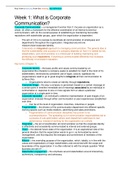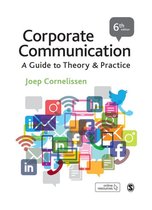Key: from a lecture, from the reading, key definition
Week 1: What is Corporate
Communication?
Corporate Communication = a management function that (1) focuses an organization as a
whole, (2) offers a framework for the effective coordination of all internal & external
communication, with (3) the overall purpose of establishing & maintaining favourable
reputations with stakeholder groups, upon which the organization is dependent.
- The aim of CC is to oversee & coordinate all communication of employees and
departments throughout the organization. Integrated around one
mission/vision/corporate identity.
- It demands an integrated approach to managing communication. The general idea is
that the sustainability and success of a company depends on how it is viewed by key
stakeholders, and communication is a critical part of building maintaining and
protecting such reputations. If anything is communicated differently this increases
the difficulty of consistent reputation.
Key terms (Chapter 1):
- Corporate Identity = the basic profile and values communicated by an
organization/the character a company seeks to establish for itself in the mind of it’s
stakeholders, reinforced by consistent use of logos, colours, typefaces etc
(organizations need to go to great lengths to integrate all their communication to
achieve this).
o Organizations what to create an identity through reputations.
- Corporate Image = the way a company is perceived, based on a certain message at
a certain point in time/the immediate set of meanings associated by an individual in
confrontation or response to one or more signals from or about a particular
organization at a single point in time.
- Corporate reputation = an individual’s collective representation of past images of an
organization (induced through either communication or past experiences) established
over time.
o Can be at the level of organization, branches, industries or people.
- Fragmentation = the division of the communication department into different specific
working spaces such as media relations, advertising and sales promotions.
o Fragmentation of communication disciplines has proven to be
counterproductive. The spreading out of communication responsibilities led to
a process of sub-optimization where each department optimises its own
performance, instead of working for the organisation as a whole.
- Integration = the act of coordination all communication so that the corporate identity
is effectively and consistently communicated to internal and external groups.
- Vision = the desired future state of the organization. It is an aspirational view of the
general direction that the organization wants to go in, as formulated by senior
management, and that requires the energies and commitment of members of the
organization.
- Mission = the overriding purpose of the organization, which, ideally, is in line with the
values and expectations of major stakeholders and concerned with the scope and
boundaries of the organization. It is often referred to with the simple question ‘What
business are we in?
- Stakeholder engagement = the emphasis around stakeholders around interactivity,
authenticity, transparency and advocacy.
,Key: from a lecture, from the reading, key definition
o Transparency = the company lets information flow freely between them and
the stakeholders.
o Authenticity = the quality or condition of communication (e.g., leadership
communication) being authentic trustworthy or genuine.
o Advocacy = an attempt to try to change stakeholder expectations and public
opinions on an issue through issue campaigns and lobbying.
o Objectives = the more precise statements of direction which are to be
achieved by strategic initiatives or strategies.
- Strategies = involve actions and communications that are linked to objectives and are
often specified in terms of specific functions.
- Positioning = the way in which a company is communicated to its target market,
describing the attributes and values of the company and as added value/appeal
relative to its customers and the competition.
- Shareholders = share the ownership of an organization
- Stakeholders = any group or individual who can affect or is affected by the
achievement of an organization’s objectives.
o Essential stakeholders are: (1) Consumers → directly related to sales, (2)
Employees → identity building.
Organizational Communication
1st Perspective: Communication happens within organizations.
- An informational view e.g., emails, conferences, meetings and presentations.
- A conventional/traditional definition of Organization = a group of people working
together in a coordinates & structed fashion, to reach a common goal.
- Communication is considered separate to an organization, but simultaneously
shaped by an organization.
o Metaphor: organization is a container in which people can collaborate,
communication is flowing in the container and like water, it takes the shape of
the container.
- While this seems correct, it fails to take into account the complexity of
communication. It is fine for daily communication (e.g., planning a schedule,
transmitting information, giving instructions), but not for more complex
communication (e.g., giving bad news, mediating a dispute).
- It constitutes a social reality thar produces unfavourable outcomes.
2nd Perspective: Organizations as Communication.
- Organizations consist of communication → when people communicate, they pass
information while simultaneously giving meaning to things. Organizations are
communicative, they’re an ongoing collection of symbols, interpretations, messages
and interactions.
- Communication Constitution of Organizations (CCO)
- Communication is no longer just the transmission of infomation, but a fundamental
process that shapes our reality; continually interpretive and negotiating means.
o It makes up the social world, making it a constitutive view.
- Unlike the 1st POV, this constitutive view enables us to question and investigate key
organizational realities and not just accept them as given.
- This (function) focuses on the organisation as a whole and on the important task of
how an organisation presents itself to all its key stakeholders, both internal and
external.
,Key: from a lecture, from the reading, key definition
Approaches to Corporate Communication:
1. Informative Approach
• Communication is just the transmission of information from sender to receiver
• Who says it? What do they say? Who do they say it to? What channel do they
use? What effect does it have?
• Receiver understands in the intended way
• The aim is to reach target groups with the necessary information.
• E.g. “Newspapers informed the public about the company, consumers
acquired knowledge about it.”
• An informational strategy is informing someone about something. Press
releases, newsletters and reports on a company website are often simply
meant to make information available about the organization to its
stakeholders. Such a strategy may create awareness of organizational
decisions and may also contribute to a degree of understanding of the
reasons for these decisions.
2. Persuasive Approach
• This approach recognises that communication has limited affects
• Looks at the effect on cognition or behaviours (marketing)
• The aim is to reach people & have an affect e.g., improving public image.
• Elaboration Likelihood Model (Aims to explain the different ways of
processing media, why they are used and the outcomes on attitude change)
• Cognitive Dissonance (the distressing mental state/discomfort from when
there is a discrepancy between attitude and behaviour, OR between 2
attitudes (cognitive inconsistency)
, Key: from a lecture, from the reading, key definition
• E.g. “Employees were outraged about the article” (this is about the impact of
communication on emotions).
• A persuasive strategy is when an organization, through campaigns, meetings
and discussions with stakeholders, tries to change and tune the knowledge,
attitude and behaviour of stakeholders in a way that is favourable to the
organization.
3. Relational Approach
• Actors are senders and receivers; communication can help build relationships
(trust) if both parties keep each other’s interests in mind.
• Trust is generated when the parties listen and incorporate each other.
• Systems theory views societies as a collection of interconnected systems,
therefore an organisation is a subsystem which aims to survive in the context
of other subsystems that interact with each other. → thus, adapting to their
surroundings.
• A communication system can help negotiate/achieve things between an
organisation and stakeholders, to maintain good relationships with actors in
the environment.
• E.g. “The CEO changes his behaviour in order to prevent damage to the
organization’s relations with stakeholders and ensure the company’s
survival.” → Environmental sensitivity is an important concept in the relational
approach
• A dialogue strategy is when both parties (organizations and stakeholders)
mutually engage in an exchange of ideas and opinions. a dialogue strategy
involves the active consultation of stakeholders and, at times, even the
incorporation of important stakeholders into the organization’s decision-
making. It involves working towards a process of mutual understanding and
mutual decisions rather than strategic self-interest on the part of the
organization.
4. Interpretative Approach
• Social constructionism → looks at meanings constructed through
communication
• Actors construct reality through communication in interaction with others.
They make sense of an organisation by talking about it, therefore everyone
who is communicating about a brand, co-creates the meaning of the brand.
• Subjective → there are multiple ‘truth’ images of reality people confirm them
by adapting their behaviour and communication to them.
• E.g. The media provide a space where information is not just transmitted (as
the informative approach assumes). Rather, through communication in the
media, actors collectively construct meaning.
5. Critical Approach
• Normative theory → what should the communication of an organization look
like?
• Idealistic → (externally) it aims to create a society free of power structures.
(internally) it aims for an open & egalitarian work environment.
• Who has power to influence public meaning construction?
• Emancipation reduces dominance of certain influencers in public meaning
construction.
• E.g., the media is a space in which actors contribute to the meaning
construction process in order to exercise power over each other.





